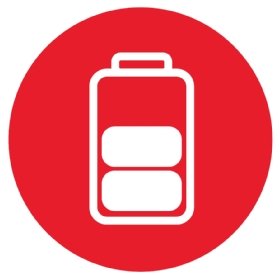milliampere-hour (mAh)
What is milliampere-hour (mAh)?
A milliampere-hour (mAh) is one-thousandth of an ampere hour (Ah), which can also be written as 1 mAh = 0.001 Ah. Both measures are commonly used to describe the energy charge that a battery can hold and how long a device will run before the battery's charge is depleted.
The ampere is the standard unit of electric current in the International System of Units. An ampere corresponds to the flow of 6.24150907 x 1018 elementary charges per second, which is equivalent to 1 coulomb.
What is mAh used for?
Milliampere-hour is often used to rate the battery capacities for smartphones, laptops, clocks, power tools, cordless appliances and other devices. The measure is also used for common household batteries such as C, D, 9V, AA and AAA.
The mAh ratings can vary significantly from one battery to the next, depending on the type of battery and how it's constructed. For example, the following batteries range from 800 mAh to 11,200 mAh (11.2 Ah):
- Dell XPS 15 laptop battery: 6,254 mAh.
- Apple iPhone Pro 14 battery: 3,200 mAh.
- Samsung Galaxy Tab S8 tablet battery: 11,200 mAh.
- DeWalt PowerStack 20V Max power tool battery: 5,000 mAh.
- Panasonic Eneloop AAA rechargeable battery: 800 mAh.
- Tenergy 9V lithium battery: 1,200 mAh.
What does mAh indicate?
The mAh rating for each battery indicates its charge capacity and how long it can run a device. This means that a 1 mAh battery can deliver a continuous current of 1 milliampere (mA) for one hour. Most batteries have much larger capacities, and most devices consume a battery's charge at a much slower rate, relative to the battery's overall capacity.

For example, the iPhone Pro 14 battery is rated as 3,200 mAh. When fully charged, the battery can hold a 3,200 mA charge. If the phone consumes an average of 200 mA per hour, it should be able to run for about 16 hours. If the usage is closer to 100 mA per hour, the phone should be able to run for nearly 32 hours.
In general, the higher the mAh, the longer the battery will last, all other factors being equal. For example, if two identical laptops contain different but comparable batteries and are supporting similar workloads, the laptop with the 8,000 mAh battery will run for longer on a fully charged battery than the laptop with the 6,000 mAh battery. That said, other factors can also affect battery life, such as extreme operating temperatures, poor charging practices or the use of substandard charging equipment.
What affects how many milliampere-hours a battery will last?
Device usage also plays an important role in how long a battery will last between charges. Suppose the user on the laptop with the 6,000 mAh battery is working on a text document and searching the web periodically, while the user on the laptop with the 8,000 mAh battery is running multiple applications, streaming movies, playing video games, browsing the web, working in a design program and carrying out a variety of other tasks. In such a scenario, the 8,000 mAh battery might lose its charge long before the 6,000 mAh battery.
Milliampere-hour vs. watt-hour
In some cases, a battery's capacity will be given in watt-hours (Wh) rather than milliampere-hours, which is especially true for laptop batteries. A watt-hour is a unit of energy equal to 1 watt of power expended over a one-hour period. Like mAh, the Wh metric provides a guideline for how long a fully charged battery should last under normal circumstances.
If you know a battery's voltage (V) and watt-hour rating, but not its mAh, you can calculate the mAh using the following formula:
mAh = Wh x 1,000 / V
For example, if a laptop contains a 11.4 V battery that's rated at 75 Wh, the capacity would be about 6,579 mAh. Unfortunately, many laptop manufacturers list only the watt-hour rating and little more, in which case, you'll have to dig deeper to find the actual mAh.
Learn how IT can address smartphone battery drain and mobile user experience and how to extend your power lifecycle with lithium-ion data center batteries.
